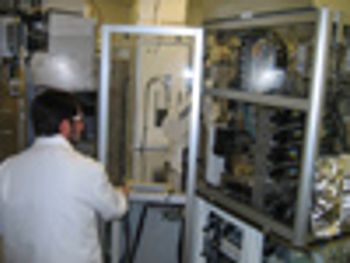
Disposables are no longer a mistrusted new technology; they're seen as a potential solution to everyday problems.
Laura Bush was editor in chief of BioPharm International.

Disposables are no longer a mistrusted new technology; they're seen as a potential solution to everyday problems.

The recent FDA decision that meat from cloned animals is safe for human consumption seems logical enough. A protein is a protein. But even if we can eat such meat, it doesn't necessarily make economic or ecological sense to do so.

Given the complexity involved in the causes, mechanisms, and kinetics of protein aggregation, industry leaders and academics should continue to share knowledge and experience in this area.

Lipoxen PLC (London, UK, www.lipoxen.co.uk) has agreed to license its "PolyXen" drug delivery technology to Baxter International Inc. (Deerfield, IL, www.baxter.com) to develop improved, longer-acting forms of Baxter's blood-clotting factors, such as Factor VIII.

In various races in the November elections, voters supported stem cell research. Now, will they prepared to fund it?

Invitrogen (San Diego, CA, www.invitrogen.com) believes that scaledown technologies can significantly improve clone selection and cell culture media development.

Generex Biotechnology Corporation (Toronto, Canada, www.generex.com) has received an Australian patent for its micellar system for delivering macromolecules through the buccal lining.

Whether it's for manufacturing drugs, characterizing cell substrates, or regulating new technology, quality systems provide a needed framework.

The US Food and Drug Administration says the final version of "Quality Systems Approaches to Pharmaceutical Good Manufacturing Practice (cGMP) Regulations," issued September 29, will help manufacturers maintain consistent high quality while allowing them to make technological improvements more easily.

A new pharmaceutical industry benchmarking study found that better manufacturing performance results when operations staff make key decisions.

A new biotech consortium in the UK believes it can develop tools to improve biopharmaceutical process development.

Recent announcements of several new biopharmaceutical development and manufacturing sites point to the continued growth and internationalization of the industry, as European-based companies expand operations in the US and vice-versa.

Taking a purist stance is always tempting. It can, however, have unintended consequences.

Novexin (Cambridge, UK, www.novexin.com) has received an additional ?200,000 grant from the UK Department of Trade and Industry (DTI) to continue development of its carbohydrate polymers to enhance the solubility and stability of proteins in solution.

The development of biotech drugs poses challenges that cross several disciplines.

Is it possible to reconcile phage therapy, which is inherently variable, with requirements for tight product characterization and control?

The US Food and Drug Administration has approved MedImmune's (Gaithersburg, MD, www.medimmune.com) supplemental biologics license application to use reverse genetics technology to create new vaccine strains for their influenza vaccines, including the intranasal FluMist vaccine.

The approvals of two groundbreaking vaccines in the last month is encouraging news. Vaccines have long been undervalued because they haven't been as profitable as other pharmaceuticals. So it's good to see them getting deserved attention that goes beyond fears of flu outbreaks.

"Clinical data is the gold standard" for setting manufacturing specifications, said Patrick Swann, PhD, acting deputy director of the Division of Monoclonal Antibodies at FDA, at a session on specification setting at the AAPS National Biotechnology Conference that was held June 19-21 in Boston.

Protein aggregation is a term that can include many types of aggregation, from rapidly reversible aggregation caused by non-covalent bonds to irreversible aggregation in the form of covalent oligomers.

Welcome to the first issue of the BioPharm International Science and Business Bulletin.

The belief that glycosylation is critical to ensuring the functionality of protein therapeutics-and preventing immunogenicity-drives many manufacturing decisions. But is it time to question this industry tenet?

In the biotech industry, everyone wants to get to market fast. But what if you have to build a manufacturing facility first? At Interphex 2006, Roger Lias, PhD, vice-president of sales and business development at Cytovance Biologics (Oklahoma City, OK, www.cytovance.com), explained how his company did it quickly. In August of this year, the company expects to complete validation of a new cGMP contract manufacturing facility for biopharmaceuticals derived from mammalian cell culture ? just 25 months after the original groundbreaking.

Alexander Fleming's original process for making penicillin was a low-volume, and presumably, labor-intensive affair. Today, it is a highly optimized, low-budget operation that is carried out only overseas. In other words, says Wei-Shou Hu, PhD, of the University of Minnesota, we engineered ourselves out of a job. Could we do the same with mammalian cell culture? Hu posed this question during a presentation at the BIO conference in April.

In recent years, FDA has made positive moves to foster innovation by streamling regulation. But the agency's recent proposal to exempt manufacturing for phase 1 clinical trials from GMP requirements seems ill advised.

In recent days, several different colleagues, in separate conversations about the industry, made remarkably similar comments.

At a recent scientific conference, a group gathered around a table to compare experiences. Participants, in turn, asked their colleagues how to avoid problem X or how to resolve challenge Y. In most cases, those responding said, "I have found method Z to work, but not all the time." In other words, it depends. Hearing about others' approaches is helpful, but each problem still must be solved individually.

Sometimes, being human is a drag. Especially in winter. The days are short and cold; the nights are longer and colder. In the gray light of midday, it's tough to be enthusiastic about anything.

You tell me whar a man gits his corn pone, en I'll tell you what his 'pinions is."

When devising business strategy or making a career move, one always looks for growth. That's precisely what has brought me to BioPharm International.